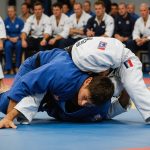Understanding the Importance of Strength Training for Spins
Strength training plays a pivotal role in enhancing spins in ice skating. It directly influences spin mechanics and stability, which are crucial for a skater’s success. By focusing on specific muscle groups, skaters can significantly improve their spinning techniques and overall performance.
Spin Mechanics and Stability
Strength training improves the core, legs, and back muscles, which are essential in stabilising a skater during spins. A strong core helps maintain balance, while powerful leg muscles allow for effective propulsion and control throughout the spin. Concentrating on these areas enables skaters to execute more precise and controlled spins.
Topic to read : Elevating equestrian excellence: strengthening the bond between athletes and their horses for unmatched performance
Muscle Groups Contribution
Certain muscle groups are vital for effective spinning. The abdominal muscles provide core stability, the quadriceps and hamstrings aid in knee flexion and extension, and the gluteal muscles offer support through hip rotation. Strengthening these areas enhances a skater’s ability to maintain form during spins, thus boosting overall performance.
Successful Skaters’ Practices
Many successful skaters attribute their outstanding spinning abilities to dedicated strength training. Skaters like Tessa Virtue and Scott Moir emphasize the importance of strength training, incorporating targeted exercises into their routines. Their dedication underlines how critical strength training is for achieving excellence in spins.
Also to read : Enhancing endurance: proven training techniques for cyclists tackling multi-stage competitions
Targeted Strength Training Exercises for Spin Enhancement
Enhancing spin in skating requires specific targeted strength exercises to build the necessary muscles and improve overall performance. These exercises focus on core, lower body, and upper body strength to ensure a balanced and powerful spin.
Core Strengthening Exercises
The core is crucial for maintaining balance and rotation when spinning. Plank variations develop core stability by engaging the abdominal and back muscles. Begin with standard planks and progress to more challenging side or forearm planks. Russian twists are essential for enhancing rotational strength. Sitting with feet elevated, twist the torso from side to side, holding a weight for added intensity. Leg raises help to develop the lower abdominal muscles, crucial for maintaining tight body lines during spins. By incorporating these exercises, skaters can achieve greater control and fluidity in their spins.
Lower Body Strengthening Techniques
Building leg power is vital, and exercises like squats and their variations enhance this strength. Try adding weights or performing one-legged squats for added difficulty. Lunges improve balance and strength, simulating the deep knee bend needed in many skating positions. Lastly, plyometric exercises like box jumps increase explosiveness, aiding in quicker, more forceful spins. Consistent practice of these techniques will lead to better spin execution.
Developing a Comprehensive Workout Plan
Designing an ice skating workout plan involves combining skating practice with a strength training schedule. Structure your routine carefully to incorporate both disciplines within a weekly framework. For example, allocate specific days for on-ice sessions focusing on skills like jumps or a spins-focused training program, while reserving others for off-ice activities like core and leg workouts. This approach helps balance physical demands, enhancing overall skating performance.
Injuries can be a concern, so integrating flexibility and recovery strategies is essential. Implement stretching routines before and after workouts to maintain flexibility and reduce the risk of injury. Don’t overlook rest and recuperation; they are vital for muscle repair and growth.
A one-size-fits-all approach doesn’t work in ice skating. Customizing your training regimen based on individual skill level is crucial. Beginners might focus more on basic moves and building foundational strength, while advanced skaters could target specific technical improvements through a spins-focused training program.
By tailoring a plan to your needs, you’ll progress more efficiently, gaining strength and skill in a balanced manner. Remember, the key is consistency combined with a structured and adaptable approach.
Tips for Proper Technique and Execution
Improving your technique in ice skating spins requires understanding the mechanics behind proper spin execution. At its core, executing a spin involves combining balance, coordination, and precise movements. Start by aligning your body correctly: your head, shoulders, and hips should be in line. This alignment ensures the spin’s axis remains straight, allowing for increased speed and skill development in skating.
A major component is balance. Much like a top, a skater must maintain their center of gravity over their spinning foot. Posture is critical; a stiff, upright back and slightly bent knee can support stability during turns. Remember that controlled breathing can assist with maintaining composure.
Avoid common mistakes like leaning slightly outward or collapsing your core, which can lead to wobbling and loss of balance. If you find yourself unsteady, practice spinning in quarter-turns to master precision and then gradually increase turn counts. Mirroring exercises and video analysis can help identify and correct errors.
Consider these tips and practice them diligently:
- Keep your posture aligned
- Focus on a straight axis
- Engage your core for stability
- Incrementally increase spin difficulty
Developing your technique through incremental progress leads to more confident and elegant spins on the ice.
Insights from Coaches and Elite Athletes
Embarking on the journey of mastering spins requires more than just basic training. Many professional skaters emphasize the role of strength training in enhancing their performance. Coaches unanimously agree that a balanced regimen incorporating both strength and technique amplifies results. They often highlight that strength training improves core stability, which is crucial for maintaining balance during spins. An elite athlete echoed this by stating that adopting targeted strength exercises significantly improved their spin precision.
Coaching Strategies for Spins
Great coaches stress innovative methods to cultivate athlete potential. Coaching strategies often include progressive overload techniques, ensuring athletes incrementally increase their physical thresholds. This approach helps in maintaining progress without risking burnout or injury.
Athlete Training Insights
Insights from seasoned athletes suggest that the combination of mental and physical preparation is paramount. This includes visualization exercises coupled with physical practice sessions. The cognitive aspect plays a pivotal role in enhancing performance under pressure.
Professional Skater Tips
Professional skaters often share tips on overcoming the fear associated with spins. Many suggest breaking down complex spins into simpler parts. By focusing on individual elements, athletes can build confidence and competence gradually, mastering spins with finesse.
Visual Aids and Supporting Resources
In the world of ice skating, utilizing visual aids can dramatically enhance your learning experience. When mastering exercise techniques, video demonstrations are invaluable. By visually understanding each movement, skaters can ensure proper form, reducing the risk of injury and optimizing performance. Websites and streaming platforms offer a plethora of training resources for skaters that cater to various skill levels.
Moreover, educational materials focusing on strength training are equally important. Numerous books and online courses are available that specialize in this area, providing detailed guidance and structured plans to enhance a skater’s physical capabilities. These resources often cover the spectrum from beginner to advanced exercises, ensuring that every skater finds value.
In the digital era, technology and apps play a pivotal role in tracking progress and workouts. Apps designed specifically for skaters can help log time spent on the ice, keep track of personal bests, and even suggest routines tailored to individual goals. Such technological aids not only streamline the training process but also motivate skaters to push their limits consistently.
In this way, leveraging both traditional and modern resources can offer a comprehensive approach to augmenting a skater’s skills, ultimately leading to greater success on the ice.











